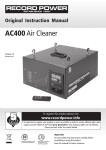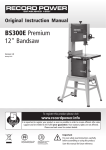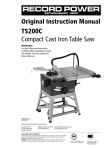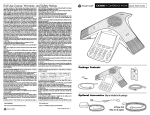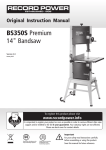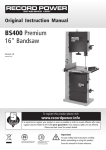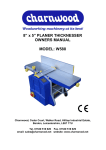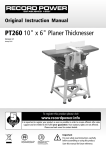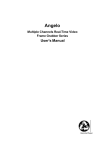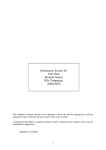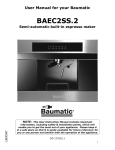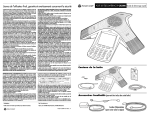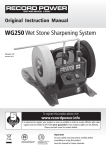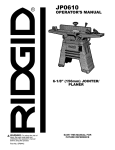Download Original Instruction Manual
Transcript
Original Instruction Manual BBS1 Benchtop Bobbin Sander BBS2 Heavy Duty Floorstanding Bobbin Sander Version 3.0 August 2013 To register this product please visit www.recordpower.info It is important to register your product as soon as possible in order to receive efficient after sales support and be entitled to the full 5 year guarantee. Your statutory rights are not affected. Please see back cover for contact details. Kg i Always wear safety glasses when using woodworking equipment. Always read the instructions provided before using woodworking equipment. Important For your safety read instructions carefully before assembling or using this product. Save this manual for future reference. 1 Contents 1 Explanation of Symbols 2 General Health & Safety Guidance 3 Additional Health & Safety Guidance for Oscillating Bobbin Sanders 4 Record Power Guarantee 5 Specifications 6 Features of the BBS1 & BBS2 Bobbin Sanders 7 Contents of the Packages 8 Assembly 9 Operation 10 Dust Extraction 11 Maintenance 12 Electrical Connection & Wiring Diagram 13 Troubleshooting 14 Parts Lists & Diagrams EU Declaration of Conformity 2 1. Explanation of Symbols The symbols and their meanings shown below may be used throughout this manual. Please ensure that you take the appropriate action wherever the warnings are used. Mandatory Instructions i Read and fully understand the instruction manual before attempting to use the machine. Indicates an instruction that requires particular attention Wear protective eyewear i i Use respiratory protective equipment i i i i Use hearing protection Use suitable protective footwear Use protective work gloves Warnings Indicates a risk of severe personal injury or damage to the machine Indicates a risk of severe personal injury from electrical shock Kg i Kg Kg Kg Risk of personal injury from lifting of heavy items i i personal injury Indicates a risk of severe i objects from airborne Risk of fire Kg i 3 2. General Health & Safety Guidance Ensure that you carefully read and fully understand the instructions in this manual before assembly, installation and use of this product. Keep these instructions in a safe place for future reference. •If the machine is suitable to be used on a workbench, ensure that the workbench is well constructed and capable of withstanding the weight of the machine. The machine should always be securely fastened to the workbench with appropriate fixings. WARNING: for your own safety, do not attempt to operate this machine until it is completely assembled and installed according to these instructions. •Where possible, floor standing machines should always be secured to the floor with fixings appropriate to the structure of the floor. WARNING: When using any machine, basic safety precautions should always be followed to reduce the risk of fire, electric shock and personal injury. Safe Operation 1. Use Personal Protective Equipment (PPE) •The operation of any machine can result in foreign objects being thrown into your eyes, which can result in severe eye damage. Protective eyewear or other suitable eye protection or face shield should be used at all times. Everyday spectacles only have impact resistant lenses. They are not protective eyewear and do not give additional lateral protection. •Use respiratory protective equipment (dust mask etc.) if the machining operation creates dust. Exposure to high levels of dust created by machining hardwoods, softwoods and man made composite boards can result in serious health problems. Some imported hardwoods give off highly irritating dust, which can cause a burning sensation. The use of respiratory protective equipment should not be seen as an alternative to controlling the risk of exposure at source by using adequate dust extraction equipment. •The use of ear plugs or ear defenders is recommended when the machine is in use, particularly if the noise level exceeds 85 dB. •Wear suitable protective gloves when handling cutting tools or blades. Gloves should NOT be worn when using the machine as they can be caught in moving parts of the machine. •Non-slip safety footwear is recommended when using the machine and handling large work pieces. 2. Dress appropriately •Do not wear loose clothing, neckties or jewellery; they can be caught in moving parts of the machine. • Roll up long sleeves above the elbow. • Wear protective hair covering to contain long hair. 3. Safety warnings • Find and read any warning labels on the machine •It is important that any labels bearing health and safety warnings are not removed, defaced or covered. Replacement labels can be obtained by contacting our Customer Service Department. 4. Familiarise yourself with the machine •If you are not thoroughly familiar with the operation of this machine, obtain advice from your supervisor, instructor, or other qualified person or contact your retailer for information on training courses. Do not use this machine until adequate training has been undertaken. 5. Take care when moving or positioning the machine •Some machines can be very heavy. Ensure the floor of the area in which the machine is to be used is capable of supporting the machine. •The machine and its various components can be heavy. Always adopt a safe lifting technique and seek assistance when lifting heavy components. In some cases it may be necessary to use mechanical handling equipment to position the machine within the work area. •Some machines have optional wheel kits available to allow them to be manoeuvred around the workshop as required. Care should be taken to install these according to the instructions provided. •Due to the nature of the design of some machines the centre of gravity will be high making them unstable when moved. Extreme care should be taken when moving any machine. 6. The machine should be level and stable at all times •When using a leg stand or cabinet base that is designed to be fitted to the machine, always ensure that it is securely fastened to the machine using the fixings provided. •The floor surface should be sound and level. All of the feet of the machine should make contact with the floor surface. If they do not, either re-locate the machine to a more suitable position or use packing shims between the feet and the floor surface to ensure the machine is stable. 7. Remove adjusting keys and wrenches •Ensure that all adjusting wrenches and keys are removed before switching the machine ‘ON’. There is a risk of severe personal injury or damage to the machine from airborne objects. 8. Before switching the machine ‘ON’ • Clear the machine table of all objects (tools, scrap pieces etc.) •Make sure there is no debris between the work piece and the table / work support. •Ensure that the work piece is not pressed against, or touching the saw blade or cutting tool. •Check all clamps, work holding devices and fences to ensure that they are secure and cannot move during machining operations. •Plan the way that you will hold and feed the work piece for the entire machining operation. 9. Whilst machining •Before starting work, watch the machine while it runs. If it makes an unfamiliar noise or vibrates excessively, switch the machine ‘OFF’ immediately and disconnect it from the power supply. Do not restart until finding and correcting the source of the problem. 10. Keep the work area clear •Working clearances can be thought of as the distances between machines and obstacles that allow safe operation of every machine without limitation. Consider existing and anticipated machine needs, size of material to be processed through each machine and space for auxiliary stands and/or work tables. Also consider the relative position of each machine to one another for efficient material handling. Be sure to allow yourself sufficient room to safely operate your machines in any foreseeable operation. •Cluttered work areas and benches create the risk of accidents. Keep benches clear and tidy away tools that are not in use. •Ensure that the floor area is kept clean and clear of any dust and debris that may create trip or slip hazards. 11. Consider the work area environment • Do not expose the machine to rain or damp conditions. •Keep the work area well lit and ensure that there is artificial lighting available when there is insufficient natural light to effectively light the work area. Lighting should be bright enough to eliminate shadow and prevent eye strain. •Do not use the machine in explosive environments eg. in the presence of flammable liquids, gases or dust. •The presence of high levels of dust created by machining wood can present a risk of fire or explosion. Always use dust extraction equipment to minimise the risk. 12. Keep other persons away (and pets) • The machine is designed to be used by one person only. •Do not let persons, especially children, touch the machine or extension cable (if used) and keep visitors away from the work area. •Never leave the machine running unattended. Turn the power supply off and do not leave the machine unattended until it comes to a complete stop. •If the work area is to be left unattended, all machinery should be switched ‘OFF’ and isolated from the mains power supply. 4 2. General Health & Safety Guidance 13. Store machines safely when not in use •When not in use, machines should be stored in a dry place, out of reach of children. Do not allow persons unfamiliar with these instructions or with the machine to operate it. 14. Do not overreach •Choose a working position that allows your body to remain balanced and feed the work piece in to the machine without overreaching. • Keep proper footing and balance at all times. 15. Electrical supply •Electrical circuits should be dedicated to each machine or large enough to handle combined motor amp loads. Power outlets should be located near each machine so that power or extension cables are not obstructing high-traffic areas. Observe local electrical guidelines for proper installation of new lighting, power outlets, or circuits. • The machine must be connected to an earthed power supply. •The power supply must be equipped with a circuit breaker that provides short circuit, overload and earth leakage protection. •The voltage of the machine must correspond to the voltage of the mains power supply. •The mains plug fitted to the machine should always match the power outlet. Do not modify the plug in any way. If a replacement plug is required it should be fitted by a competent person and of the correct type and rating for the machine. •If you are unsure about any electrical connections always consult a qualified electrician. 16. Avoid unintentional starting of the machine •Most machines are fitted with a no-volt release (NVR) switch to prevent unintentional starting. If in doubt always ensure the machine switch is in the ‘OFF’ position before connecting it to the power supply. This means the machine will not automatically start up after a power cut or switching on of the power supply, unless you first reset the start switch. 17. Outdoor use • Your machine should not be used outdoors. 18. Extension cables •Whenever possible, the use of extension cables is not recommended. If the use of an extension cable is unavoidable, then it should have a minimum core cross section of 2.5 mm² and limited to a maximum length of 3 metres. •Extension cables should be routed away from the direct working area to prevent a trip hazard. 19. Guard against electric shock •Avoid body contact with earthed or grounded surfaces such as pipes and radiators. There is an increased risk of electric shock if your body is earthed or grounded. 20. Always work within the machine’s intended capacities •Operator safety and machine performance are seriously adversely affected if attempts to make the machine perform beyond its limits are made. 21. Do not abuse the power cable •Never pull the power cable to disconnect it from the power socket. Always use the plug. • Keep the power cable away from heat, oil and sharp edges. • Do not use the power cable for carrying or moving the machine. • Do not attempt to machine more than one work piece at a time. •When feeding the work piece towards the blade or cutting tool never position your hands in direct line of the cutting path. Avoid awkward operations and hand positions where a sudden slip could cause your hand or fingers to move into the machining area. 23. Stay alert •Safety is a combination of operator common sense and alertness at all times when the machine is being used. •Use all machines with extreme care and do not use the machine when you are tired or under the influence of drugs, alcohol or medication. 24. Use the correct tool for the job •Do not use the machine for any purpose other than which it was designed. •When selecting replacement cutting tools and blades, always ensure that they are designed to cut the material that you intend to use them for. If in any doubt seek further advice from the manufacturer. 25. Connect dust extraction equipment •Always use dust extraction equipment. The dust extractor should be of suitable size and capacity for the machine that it is connected to and have a filtration level appropriate to the type of waste being collected. Refer to the relevant section of the manual for details of the specific dust extraction requirements for this machine. •The dust extractor should be switched ‘ON’ before starting the machine that it is connected to. The dust extractor should be left running for 30 seconds after the last machining operation is complete in order to clear any residual waste from the machine. 26. Ensure that the machine is correctly guarded •Never use the machine if any of the standard safety guards and equipment are removed or damaged. •Some machines incorporate safety interlocks to prevent the machine from being used without the guards in place. Never attempt to bypass or modify the interlocks to allow the machine to be used without the guards in place. 27. Maintain your machine with care •This manual gives clear instructions on installation, set up and operation of the machine and also details any routine and preventative maintenance that should be performed periodically by the user. •Remember always to switch off and unplug the machine from the power supply before carrying out any setting up or maintenance operations. •Follow any instructions for the maintenance of accessories and consumables. •Do not use compressed air to clean the machine. Always use a brush to dislodge dust in places that are awkward to reach and a dust extractor to collect the waste. •Inspect electric cables periodically and, if damaged, have them replaced by an authorised service facility or qualified electrician. •Inspect extension cables (if used) periodically and replace if damaged. 28. Keep cutting tools sharp and clean •Correctly maintained cutting tools are easier to control and less likely to bind. •Cutting tools and blades can become hot during use. Take extreme care when handling them and always allow them to cool before changing, adjusting or sharpening them. 22. Secure the work piece •Ensure that the work piece is securely held before starting to machine it. •When working within 300 mm of the machining area, always use a push stick to feed the work piece in to the blade or cutting tool. The push stick should have a minimum length of 400 mm. If the push stick becomes damaged, replace it immediately. •Use extra supports (roller support stands etc.) for any work pieces large enough to tip when not held down to the table top. •Do not use another person as a substitute for a table extension, or as additional support for a work piece that is longer or wider than the basic table, or to help feed, support, or pull the work piece. 5 2. General Health & Safety Guidance 29. Disconnect the machine from the power supply •When not in use, before servicing, changing blades etc. always disconnect the machine from the power supply. 30. Check for damaged parts •Before each use of the machine, it should be carefully checked to determine that it will operate properly and perform its intended function. •Check for alignment of moving parts, binding of moving parts, breakage of parts and any other conditions that may affect the operation of the machine. •A guard or other part that is damaged should be properly repaired or replaced by a qualified person unless otherwise indicated in this instruction manual. •Do not use the machine if the switch does not turn the machine ‘ON’ and ‘OFF’. 31. Warning! •The use of any accessory or attachment, other than those recommended in this instruction manual, or recommended by our Company may present a risk of personal injury or damage to the machine and invalidation of the warranty. 32. Have your machine repaired by a qualified person •This machine complies with the relevant safety rules and standards appropriate to its type when used in accordance with these instructions and with all of the standard safety guards and equipment in place. Only qualified persons using original spare parts should carry out repairs. Failure to do this may result in considerable danger to the user and invalidation of warranty. 33. Caution! Motor may become hot during use • It is normal for motors on some machines to become hot to the touch during use. Avoid touching the motor directly when in use. • Have defective switches replaced by a qualified person. 3. Additional Health & Safety Guidance for Oscillating Bobbin Sanders Safe Operation 1. Familiarise yourself with the machine •Machining operations using bobbin sanders present less of a risk than other sanding machines. Most accidents with bobbin sanders are caused by the work piece being thrown from the sanding surface or by loose clothing or fingers being caught between the moving parts of the machine. •The machine is designed for sanding wood and composite board (plywood, MDF etc.). It should not be used for sanding any other materials. 2. Before switching the machine ‘ON’: •Use extra caution when working with large, very small or awkward work pieces. •When sanding irregularly shaped work pieces, plan your work support so it will not slip and be pulled from your hands. • Never use the machine to finish pieces too small to hold by hand. •Do not apply excessive force to the work piece. Press the work piece against the sanding surface only hard enough to let it sand without slowing the machine or binding • Keep fingers away from the area between the table and sanding surface. • Keep your face and body to one side, out of line of a possible throwback. •Check the condition of the sanding sleeve and bobbin for damage or fraying. Defective sanding sleeve or bobbins should be replaced immediately. 4. This machine falls under the scope of the ‘Health & Safety at Work etc. Act 1974’, and the ‘Provision & Use of Work Equipment Regulations 1998’. In addition the elimination or control of risks from wood dust is included in the above regulations and the ‘Control of Substances Hazardous to Health (COSHH) Regulations 2002’. We recommend that you study and follow these regulations. •Make sure there are no nails or foreign objects in the part of the work piece to be sanded. Further guidance is available from The Health & Safety Executive and their website www.hse.gov.uk. •Ensure that the sanding table is secure and that any fixings which allow adjustment are fully tight. •Plan your work to avoid throwbacks – the work piece can catch on the moving sanding surface and will be torn from your hand. For further help on any of the above matters please contact our Customer Services Department: 3. Whilst machining: Email: [email protected] •Always apply the work piece to the table / work support before it makes contact with the sanding surface. Tel: 01246 571 020 6 4. Record Power Guarantee “Products” means the Products sold by Record Power subject to these terms and conditions; “Record Power” is Record Power Limited, whose company registration number is 4804158 and registered office address is Centenary House, 11 Midland Way, Barlborough Links, Chesterfield, Derbyshire, S43 4XA and sells through a network of Authorised Dealers; “Authorised Distributor” is the nominated importer for your region who will generally sell through a network of Authorised Dealers. Details of Authorised Distributors for specific countries can be found in the Product manual or at www.recordpower.info; “Authorised Dealer” is a retailer or business authorised to sell Record Power Products to end users. 1 Guarantee 1.1 Record Power guarantees that for a period of 5 years from the date of purchase the components of qualifying Products (see clauses 1.2.1 to 1.2.9) will be free from defects caused by faulty construction or manufacture. 1.2 During this period Record Power, its Authorised Distributor or Authorised Dealer will repair or replace free of charge any parts which are proved to be faulty in accordance with paragraphs 1.1 above provided that: 1.2.1 you follow the claims procedure set out in clause 2 below; 1.2.2 Record Power, our Authorised Distributor or Authorised Dealer are given a reasonable opportunity after receiving notice of the claim to examine the Product; 1.2.3if asked to do so by Record Power, its Authorised Distributor or Authorised Dealer, you return the Product, at your own cost, to Record Power's premises or other approved premises such as those of the Authorised Distributor or supplying Authorised Dealer, for the examination to take place; 1.2.4the fault in question is not caused by industrial use, accidental damage, fair wear and tear, wilful damage, neglect, incorrect electrical connection, abnormal working conditions, failure to follow our instructions, misuse, or alteration or repair of the Product without our approval; 1.2.5the Product has been used in a domestic environment only; 1.2.6 the fault does not relate to consumable Products such as blades, bearings, drive belts or other wearing parts which can reasonably be expected to wear at different rates depending on usage (for full details contact Record Power or your local Authorised Distributor); 2 Claims Procedure 2.1 In the first instance please contact the Authorised Dealer who supplied the Product to you. In our experience many initial problems with machines that are thought to be due to faulty parts are actually solved by correct setting up or adjustment of the machines. A good Authorised Dealer should be able to resolve the majority of these issues much more quickly than processing a claim under the guarantee. 2.2 Any damage to the Product resulting in a potential claim under the guarantee must be reported to the Authorised Dealer from which it was purchased within 48 hours of receipt. 2.3If the Authorised Dealer who supplied the Product to you has been unable to satisfy your query, any claim made under this Guarantee should be made directly to Record Power or its Authorised Distributor (for details of the Authorised Distributor in your country please see your Product manual or check www.recordpower.info for details). The claim itself should be made in a letter setting out the date and place of purchase, and giving a brief explanation of the problem which has led to the claim. This letter should then be sent with proof of the purchase date (preferably a receipt) to Record Power or its Authorised Distributor. If you include a phone number or email address this will help to speed up your claim. 2.4Please note that it is essential that the letter of claim reaches Record Power or its Authorised Distributor on the last day of this Guarantee at the latest. Late claims will not be considered. 3 Limitation of Liability 3.1 We only supply Products for domestic and private use. You agree not to use the Product for any commercial, business or re-sale purposes and we have no liability to you for any loss of profit, loss of business, business interruption or loss of business opportunity. 3.2This Guarantee does not confer any rights other than those expressly set out above and does not cover any claims for consequential loss or damage. This Guarantee is offered as an extra benefit and does not affect your statutory rights as a consumer. Notice 4 This Guarantee applies to all Products purchased from an Authorised Dealer of Record Power within the United Kingdom of Great Britain and Northern Ireland. Terms of Guarantee may vary in other countries – please check with the Authorised Distributor in your country (details of the Authorised Distributor for your country can be found in the manual or at www.recordpower.info). 1.2.7the Product has not been used for hire purposes, by you or by a previous owner; 1.2.8 the Product has been purchased by you as the guarantee is not transferable from a private sale. 1.2.9where the Product has been purchased from a retailer, the 5 year guarantee is transferable and begins on the date of the first purchase of the Product and in the event of a claim under this guarantee proof of the original purchase date will be required to validate the warranty period. 7 5. Specifications BBS1 BBS2 Speed: 1400 rpm 1400 rpm Oscillation Stroke: 24 mm 30 mm Table size: 380 mm diameter 500 mm diameter Table tilt: 0 - 45º 0 - 45º Motor: 1/2 hp / 370 W / 230 V / 50 Hz 1 hp / 750 W / 230 V / 50 Hz Full load current: 1.6 A 3.5 A Noise emission: Sound power level < 80.1 dB (A) Sound power level < 80.1 dB (A) Sound pressure level < 69.6 dB (A) Sound pressure level < 73.5 dB (A) 6. Features of the BBS1 & BBS2 Bobbin Sanders 9 1 2 3 7 8 4 6 5 1 Sanding bobbin 6 Table insert caddy 2 Work table 7 On / off switch with emergency stop 3 Table securing knob 8 Table tilt handle 4 Machine body 9 Table insert 5 Bobbin storage caddy 8 7. Contents of the Packages 3 BBS1 Benchtop Bobbin Sander 1 2 6 4 1 BBS1 Benchtop Bobbin Sander 5 Rubber feet x 4 2 Sanding bobbin & sleeve, 20 x 90 mm 6 Table inserts x 4 3 Sanding bobbin & sleeve, 50 x 140 mm 4 17 & 14 mm open ended wrenches x 2 5 BBS2 Heavy Duty Floorstanding Bobbin Sander 1 7 4 5 3 2 6 1BBS2 Heavy Duty Floorstanding Bobbin Sander 5 21 & 19 mm open ended wrenches x 2 6 Rubber feet x 4 2 Sanding bobbin & sleeve, 20 x 140 mm 7 Table inserts x 6 3 Sanding bobbin & sleeve, 50 x 230 mm 4 Sanding bobbin & sleeve, 76 x 230 mm Please note: Bobbins and sleeves shown above in the machines are for illustrative purposes only. 9 8. Assembly Fig. 8.1 Kg Kg Caution: The machine is heavy and may require two i person lifting Remove the Bobbin Sander from the packaging. The machine comes ready assembled apart from the sanding attachments and the rubber feet. i Attaching the Rubber Feet Lower the machine onto its side. Remove the feet from the plastic wrapping. Remove the nut and washer from the thread. Locate the four mounting points on the underside of the machine. Insert the thread into the hole so that the rubber foot points downward, Fig 8.1. Put on the washer followed by the nut. Tighten with a wrench. Repeat this operation for the other three feet. Site the machine at a suitable height enabling sanding operation to be carried out comfortably and safely. Installing the Sandpaper on to the Rubber Cylinder or Bobbins Kg Caution: Make sure the machine is isolated from the supply before any maintenance, cleaning or adjustments are undertaken. Fig. 8.2 Nut Compression washer Bobbin Compression washer Sanding sleeve Shaft Kg i i If you want to change the grade of sanding paper already attached to the bobbins supplied with the machine then proceed as follows. The bobbin consists of a rubber body with a shaft passing through the centre, Fig 8.2. At either end of the body are two large compression washers. Fig. 8.3 At the top is a nut and washer to secure the sanding sleeve. The lower part of the shaft is threaded and locates in the motor drive. Please note: The shaft threads at the top and bottom of the bobbin are left handed. Remove the nut using a suitable wrench, Fig 8.3, lift away the washer and slide the sanding sleeve clear of the bobbin. If removal was difficult sprinkle a smalli amount of talcum powder onto the rubber to aid fitting the new sandpaper sleeve. Various grades of sanding sleeve are available for different applications. See your stockist for replacement of sanding sleeve. Offer the sanding sleeve to the rubber body, Fig 8.4. Slide onto the rubber body so it fits centrally with no edges overhanging. Fig.8.4 Replace the washer and nut. With a wrench tighten the nut to expand the rubber body. This will grip the sanding sleeve. Do not over-tighten as this will distort the rubber body. 10 8. Assembly Installing the Bobbin on to the Machine Fig. 8.5 Lower the bobbin down through the top of the machine. Locate the thread on the bobbin spindle into the thread on the motor drive spindle. Select two open ended wrenches, Fig 8.5. With one wrench hold the motor drive spindle and with the other wrench tighten the bobbin spindle. Do not over-tighten. Selecting Table Insert The machine comes with two types of table insert for each bobbin size. There is one with a round opening and one with an oval opening. For 90º sanding choose the insert with the round opening, Fig 8.6. Notice the cutout on the edge of the table insert. This aligns with the roll pin in the recess on the table, Fig 8.7. Lower into position making sure the table insert locates in the recess and is flush with the table. Checking the Table Top is Square to the Bobbin Fig. 8.6 Using a suitable 90º square placed on the table top, move the square to the bobbin to check alignment, Fig 8.8. If the table is not square, adjustment can be made. Located under the work table are eccentric table stops which, Fig 8.9. Loosen the locking knob, loosen the table stop screws then rotate the table stops until the table is at 90º with the bobbin. Tighten the table stop screws and locking knob. Slacken the pointer screw and align with the 0º position on the scale and re-tighten screw. Fig. 8.7 Cutout Pin Fig. 8.8 Fig. 8.9 Eccentric table stop Scale Locking knob Pointer 11 9. Operation Tilting the Table Fig. 9.1 NOTE: Remove the table insert with the circular opening before tilting the table, otherwise it may be damaged. Knurled locking ring The table will tilt 0° - 45°. To loosen the table, first loosen the locking knob then also loosen the i knurled locking ring which is located behind the table rotation handle on the opposite side of the table trunnion, see Fig 9.1. Once the desired angle has been achieved, tighten the two stop bolts and knurled locking ring. Table rotation handle Locate the table insert with the oval opening and place into the table top, Fig 9.2. Starting & Stopping the Bobbin Sander Fig. 9.2 To turn the bobbin sander on, lift the red emergency stop switch on the front of the machine body and press the green switch marked ‘I’, Fig 9.3. To stop the machine in normal use, lift the red emergency stop button and press the red button marked ‘O’. To stop the machine in an emergency, press the large red emergency stop button on the front of the machine body, Fig 9.4. In the Event of a Blockage or if the Machine Stalls If the bobbin sander stalls during use, simply reducing pressure on the bobbin by removing the work piece will allow the sanding bobbin to return to normal speed. If the bobbin sander has a tendency to stall during use, this could indicate that either too much pressure is being exerted on the work piece, or that the sanding sleeve is at the end of its working life and needs to be replaced. In the event of a blockage (for example, if the work piece becomes trapped against a fixed part of the machine) switch off the machine immediately by pressing the emergency stop button. Fig. 9.3 Locate and rectify the source of the blockage and ensure that the sanding bobbin can be rotated freely by hand before attempting to re-start the machine. To re-start the machine, press the green button marked ‘I’ as described above. In the Event of a Power Failure The bobbin sander is fitted with a no volt release (NVR) switch to protect the user against automatic starting of the machine when the power is restored after a power failure. In the event of a power failure, first locate and rectify the source of the failure. If the fault is within the power circuit of the workshop, there may be an underlying cause (circuit overload etc.) that should be investigated by a qualified electrician, before attempting to restore the power supply. Fig. 9.4 Once the power is restored, the machine can be re-started by pressing the green button marked ‘I’ on the switch as described above. 12 9. Operation Fig. 9.5 Using the Bobbin Sander Kg i Kg Caution: Never start the machine with work in contact with the bobbin. Start the machine and wait until the motor has reached full speed before using. i Looking from above the machine, the spindle turns in a clockwise direction, Fig 9.5. Always feed the workpiece from right to left, in the direction of rotation. Using the Bobbin Sander at Angles up to 45º Take out the round insert and store carefully. Put in the oval insert and slacken the table securing knobs on either side of the machine. Tilt the table to the desired angle and re-tighten the ratchet levels. Feed the work into the machine always with the direction of rotation, Fig 9.6. Fig. 9.6 PLEASE NOTE: Always bear in mind that when the table is tilted the angle required will only be achieved. i PLEASE NOTE: To sand a workpiece to the angle of the table, always ensure the workpiece only comes into contact with the bobbin at the front of the machine, perpendicular to the axis of table tilt. i Dust Extraction Fig. 9.7 Both the BBS1 and BBS2 are fitted with a 50 mm diameter dust extraction outlet, located on the rear of the machine beneath the table. See Fig 9.7. A suitable dust extraction machine must be connected to this outlet to minimise the user's exposure to dust. 13 10. Dust Extraction The Importance Of Dust Extraction Before the machine is started, ensure that adequate dust extraction provisions have been installed. Dust extraction is extremely important not only for health and safety but also for the correct upkeep of the machine. Saw dust can cause the machine not to operate properly or even fail completely. By keeping the machine free of large amounts of waste the performance will be optimised. If a large amounts of MDF or toxic woods are to be cut we recommend that there is a good ventilation system in place and that in addition to proper extraction a mask or respirator be worn as minimum protection. Record Power Extractors Record Power offer a range of high quality dust extractors, we offer both drum and bag type extractors which filter down 0.5 micron providing protection from harmful fine dusts. All Record Power dust extractors & chip collectors have 100 mm inlets and hoses. DX1000 High Filtration Dust Extractor Drum type extractor, 45 litre capacity, single 1 kW motor, suitable for intermittent use ie must be switched off for 20 minutes every hour. 0.5 micron filtration Drum type extractor, 50 litre capacity, single 1 kW motor, suitable for intermittent use ie must be switched off for 20 minutes every hour. 0.5 micron filtration RSDE/2A High Filtration Dust Extractor with Auto Switching Drum type extractor, 50 litre capacity, single 1 kW motor, auto switching allows the machine to be turned on and off as machines and power tools are operated. Suitable for intermittent use ie must be switched off for 20 minutes every hour. Maximum auto switch capacity tools up to 1.1 kW. 0.5 micron filtration Bandsaws Circular saws Sanders Intermittent usage 3 3 RSDE2 3 CX2000 Compact Chip Extractor Medium capacity chip collector, with a powerful 0.56 kW induction motor. An extremely smooth running unit suitable for continuous usage. Very quiet impeller system extracts dust and chippings. CX3000 Chip Collector Larger capacity chip collector, with a more powerful 0.75 kW induction motor and heavy duty construction. An extremely smooth running unit suitable for continuous usage. Very quiet impeller system extracts dust and chippings. RSDE2 High Filtration Dust Extractor DX1000 RSDE1 DX5000 High Filtration Dust Extractor Bag type extractor, 200 litre capacity, Twin 1 kW motor, suitable for heavy usage ie if one motor is switched off for 20 minutes then the other can be used thus enabling continuous usage. Or both motors can be used simultaneously giving maximum suction but in this mode the extractor must be switched off for 20 minutes every hour. 0.5 micron filtration CX2600 Chip Collector Large capacity chip collector, with a powerful 0.37 kW induction motor. An extremely smooth running unit suitable for continuous usage. Very quiet impeller system extracts dust and chippings. Suitable for chip collection or finer dust using the optional filter cartridge RSDE1 High Filtration Dust Extractor Drum type extractor, 45 litre capacity, single 1 kW motor, suitable for intermittent use ie must be switched off for 20 minutes every hour. 0.5 micron filtration DX4000 High Filtration Dust Extractor Drum type extractor, 80 litre capacity, Twin 1 kW motor, suitable for heavy usage ie if one motor is switched off for 20 minutes then the other can be used thus enabling continuous usage. Or both motors can be used simultaneously giving maximum suction but in this mode the extractor must be switched off for 20 minutes every hour. 0.5 micron filtration Suitable for chip collection or finer dust using the optional filter cartridge Air Cleaners It is strongly advised to also use an air cleaner to remove the fine airborne dust present in the workshop which cannot be removed using machine extraction. Record Power offer a range of air cleaners suitable for all home workshops. Please contact your preferred stockist or visit www.recordpower.info. RSDE/2A DX4000 DX5000 CX2000 CX2600 CX3000 3 3 3 Recommended Recommended Recommended Recommended Recommended Recommended Bandsaws Circular saws Sanders Heavy usage 3 3 Recommended Recommended Planer Thicknessers Spindle Moulders Universals Intermittent usage Planer Thicknessers Spindle Moulders Universals Heavy usage Dust Extraction System Intermittent usage 3 3 Recommended Recommended 3 3 3 3 3 Can be used Recommended Recommended Recommended Recommended 3 3 Can be used Recommended 3 3 3 Recommended Recommended 3 Can be used Recommended 14 11. Maintenance Periodic maintenance of the machine is necessary to maximise longevity of the machine. The maintenance procedures detailed below aim to provide guidance for most routine areas of maintenance but should not be considered to be an exhaustive list. After Each Use of the Machine Clean the machine with a soft brush and use a suitable high filtration dust extractor to remove residual waste. Check all components for sign of wear or damage and replace as necessary. Ensure the dust extraction outlet is clear of any obstructions and the dust extraction machine is in full working order. Weekly Clean and lubricate the following parts using a silicone based spray such as CWA195 Silicone Spray or similar dry lubricant. Do not use oil: Table trunnion mechanism. Bobbin spindle threads. Table adjustment components. Clean the worktable surface using white spirit or similar. Do not use thinners as damage to the paint finish may occur. After cleaning, apply silicone spray or similar to the table for added protection. Monthly Check for free movement and rotation of the oscillation mechanism. If problems are found please contact Record Power for assistance. 15 12. Electrical Connection & Wiring Diagram Machines supplied for use in the UK are fitted with a 3 pin plug conforming to BS1363, fitted with a fuse conforming to BS1362 and appropriate to the current rating of the machine. machine. If replacing the original fuse, always fit a fuse of equivalent rating to the original. Never fit a fuse of a higher rating than the original. Never modify the fuse or fuse holder to accept fuses of a different type or size. Machines supplied for use in other countries within the European Union are fitted with a 2 pin Schuko plug conforming to CEE 7/7. Where the current rating of the machine exceeds 13 A at 230 V, or if the machine is designated for use on a 400 V 3 phase supply a connector conforming to BS4343 (CEE17 / IEC60309) will be used. Machines supplied for use in Australia & New Zealand are fitted with a 3 pin plug conforming to AS/NZS3112. In all cases, if the original plug or connector has to be replaced for any reason, the wires within the mains power cable are colour coded as follows: 230 V machines will be fitted with a blue 3 pin connector. The wiring for this type of this connector will be the same as shown above. 400 V, 3 phase machines will be fitted with a red 4 or 5 pin connector. The wiring for this type of connector is as shown below: 230 V (Single Phase) Brown: Live (L) 400 V (3 phase) Blue: Neutral (N) Brown: Live (L1) Black: Live (L2) Grey: Live (L 3) Blue: Neutral (N) Green and Yellow: Earth (E) Green and Yellow: Earth (E) The wire coloured brown must always be connected to the terminal marked ‘L’ or coloured red. The wire coloured blue must always be connected to the terminal marked ‘N’ or coloured black. The wire coloured green and yellow must always be connected to the terminal marked ‘E’ or with the earth symbol: The wire coloured brown must always be connected to the terminal marked ‘L1’. The wire coloured black must always be fitted to the terminal marked ‘L2’. or coloured green / green and yellow. The wire coloured grey must always be connected to the terminal marked ‘L3’. It is important that the machine is effectively earthed. Some machines will be clearly marked with the double insulated logo: The wire coloured blue must always be connected to the terminal marked ‘N’ or coloured black. The wire coloured green and yellow must always be connected to the terminal marked ‘E’ or with the earth symbol In this case there will not be an earth wire within the circuit. In the case of the BS1363 plug for use in the UK, always ensure that it is fitted with a fuse conforming to BS1362 appropriate to the rating of the If in doubt about the connection of the electrical supply, always consult a qualified electrician. 16 13. Troubleshooting PROBLEM PROBABLE CAUSE REMEDY Bobbin sander does not operate. Not plugged into power outlet. Plug into power outlet. Power switch defective. Replace switch. Motor or wiring problem. Have a qualified electrician carry out repair if necessary. Faulty motor. Replace motor. Faulty fuse. Check and replace the fuse with the correct rating. Power supply fault. Identify source of power failure and rectify. Bobbin sander stalls or will not Bobbin jammed. Remove obstruction. reach full speed. Ensure dust extraction outlet is cleared. Faulty capacitor. Replace capacitor. Low voltage supply. Check voltage supply. Minimise cable extension length. Motor slows when sanding. Applying too much pressure. Apply less pressure to the workpiece when sanding. Sanding sleeve is clogged with debris. Clean or replace sleeve. Use adequate dust extraction. Sanding sleeve is worn out. Replace sanding sleeve. Faulty motor. Replace motor. Loose sanding sleeve gives impression Tighten the bobbin securing nut. of slow motor performance. Wood burns while sanding. Sanding sleeve is clogged with debris. Clean or replace sleeve. Use adequate dust extraction. Sanding sleeve is worn out. Replace sanding sleeve. Applying too much pressure. Apply less pressure to the workpiece when sanding. Sander makes excessive noise. Loose bobbin. Tighten bobbin. Damaged / irregularly worn bobbin. Replace bobbin. Possible wear or failure of internal components. Contact Record Power or your local stockist for assistance. 17 14. Parts Lists & Diagrams Parts List for BBS1 - Diagram A No. DESCRIPTION No. DESCRIPTION A-1 Machine body A-31 Table insert A-2 Work table bracket A-32 Switch box A-3 Work table bracket A-33 Table insert caddy A-4 Switch A-34 Dial indicator A-5 Work table A-35 Cross recessed pan head screws M5 x 8 mm A-6 Connection rod A-36 Cross recessed pan head screws M4 x 12 mm A-7 Rotation bracket of work table (Left) A-37 Stepped bolt A-8 Rotation bracket of work table (Right) A-38 Cross recessed countersunk screws M5 x 6 mm A-9 Ratchet handle A-39 Cross recessed pan head tapping screws ST2.9 x 13 mm A-10 Small gear A-40 Hex. nut M5 A-11 Rack A-41 Roll pin A-12 Knurled locking ring A-42 Cable gland M18 A-13 Rotating shaft A-14 Washer 6 mm A-44 Left-handed nut M10 A-15 Washer 5 mm A-45 Convex washer A-16 Hex. bolt M6 x 12 A-46 Rubber sleeve A-17 Hex. bolt M8 x 16 A-47 Washer A-18 Hex. bolt M8 x 20 A-48 Sanding sleeve A-19 Hex. bolt M6 x 16 A-49 Hex. nut M8 A-20 Hex. bolt M5 x 16 A-50 Rubber washer A-21 Eccentric table stop A-51 Nut washer A-22 Cross recessed countersunk screws M6 x 10 mm A-52 Hex. bolt M8 x 25 A-23 Rotation handle A-53 Cross recessed pan head screws M4 x 10 mm A-24 Bobbin caddy A-54 Hex. nut M10 A-25 Fixed section A-55 Spring washer 6 A-26 Movable section A-56 Washer 8 A-27 Oscillation assembly A-57 Cross recessed pan head screws M6 x 12 mm A-28 Dust extraction outlet A-58 Bottom guard 18 14. Parts Lists & Diagrams Diagram A 19 14. Parts Lists & Diagrams Parts List for BBS1 - Diagram B No. DESCRIPTION No. DESCRIPTION B-1 Motor base B-20 Hex. thin nut M8 B-2 Bobbin spindle bushing B-21 Splined plastic insert for bobbin spindle B-3 Guide column B-22 Connecting rod spacer B-4 Worm wheel frame B-23 Connecting rod axle B-5 Worm wheel spindle B-24 Cross recessed countersunk screws M4 x 6 mm B-6 Bearing gland B-25 Cross recessed pan head screws M5 x 8 mm B-7 Crank axle B-26 Hex. bolt M8 x 20 mm B-8 Crank B-27 Hex. bolt M6 x 16 mm B-9 Worm wheel B-28 Washer 8 mm B-10 Connecting rod B-29 Spring washer 8 mm B-11 Bearing 6001-2RS B-30 Self-locking nut M5 B-12 Worm gear B-31 Circlips for shafts 5 mm B-13 Cover, worm wheel frame B-32 Bearing 61804 B-14 Plastic housing for worm gear B-33 Bearing 6006 B-15 Motor B-34 Internal circlip 55 mm B-16 Bearing cover B-35 External circlip 30 mm B-17 Key 4 x 4 x 12 mm B-36 Socket head screw M5 x 6 mm B-18 Hex. socket set screws with flat point M6 x 6 B-19 Hex. bolt M8 x 75 mm 20 14. Parts Lists & Diagrams Diagram B 21 14. Parts Lists & Diagrams Parts List for BBS2 - Diagram C No. DESCRIPTION No. DESCRIPTION C-1 Rotation bracket of work table(Left) C-31 Roll pin C-2 Rotation bracket of work table(Right) C-32 Hex. thin nut M10 C-3 Rack C-33 Cross recessed pan head screws M6 x 12 mm C-4 Work table C-34 Bottom guard C-5 Work table bracket C-35 Stepped bolt C-6 Work table bracket C-36 Cross recessed countersunk screws M6 x 12 mm C-7 Switch C-37 Hex. nut M5 C-8 Rotation handle C-38 Front panel, machine body C-9 Rotating shaft C-39 Cross recessed pan head tapping screws ST3 x 10 mm C-10 Knurled locking ring C-40 Dust extraction outlet C-11 Small gear C-41 Table insert C-12 Fixed section C-42 Bobbin storage caddy C-13 Movable section C-43 Hex. bolt M5 x 16 mm C-14 Eccentric table stop C-44 Upper cover, machine body C-15 Oscillation assembly C-45 Switch box C-16 Hex. bolt M8 x 16 mm C-46 Table insert caddy C-17 Hex. bolt M6 x 16 mm C-47 Rubber washer C-18 Hex. bolt M8 x 25 mm C-48 Cross recessed pan head screws M5 x 25 mm C-19 Cross recessed pan head screws M6 x 12 mm C-49 Cross recessed pan head screws M4 x 12 mm C-20 Hex. nut M8 C-50 Cross recessed pan head tapping screws ST3 x 10 mm C-21 Cross recessed countersunk screws M5 x 6 mm C-51 Hex. bolt M8 x 30 mm C-22 Washer 6 mm C-52 Pressing pad C-23 Washer 8 mm C-53 Bobbin shaft C-24 Washer 5 mm C-54 Left-handed nut M10 C-25 Cross recessed pan head screws M5 x 8 mm C-55 Sanding sleeve C-26 Ratchet handle C-56 Washer C-27 Machine body C-57 Washer C-28 Spring washer 6 mm C-58 Rubber cylinder C-29 Rubber foot C-59 Hex. bolt M6 x 12 mm C-30 Nut 22 14. Parts Lists & Diagrams Diagram C 23 14. Parts Lists & Diagrams Parts List for BBS2 - Diagram D No. DESCRIPTION No. DESCRIPTION D-1 Motor base D-20 Hex. thin nut M8 D-2 Bobbin spindle D-21 Splined plastic insert for bobbin spindle D-3 Guide column D-22 Connecting rod spacer D-4 Worm wheel frame D-23 Connecting rod axle D-5 Worm wheel spindle D-24 Cross recessed countersunk screws M4 x 6 mm D-6 Bearing gland D-25 Cross recessed pan head screws M5 x 8 mm D-7 Crank axle D-26 Hex. bolt M8 x 20 mm D-8 Table tilt handle D-27 Hex. bolt M6 x 16 mm D-9 Worm wheel D-28 Washer 8 mm D-10 Connecting rod D-29 Washer 8 mm D-11 Bearing 6001-2RS D-30 Self-locking nut M5 D-12 Worm gear D-31 Circlips for shafts 5 mm D-13 Cover, worm wheel frame D-32 Bearing 61905 D-14 Plastic housing for worm gear D-33 Bearing 6007-2RS D-15 Motor D-34 Internal circlip 62 mm D-16 Bearing cover D-35 External circlip 35 mm D-17 Key 4 x 4 x 12 mm D-36 Cross recessed countersunk screws M4 x 6 mm D-18 Hex. socket set screws with flat point M6 x 6 mm D-37 Oilite bush D-19 Hex. bolt M8 x 85 mm 24 14. Parts Lists & Diagrams Diagram D 25 EU Declaration of Conformity Cert No: EU / BBS1 BBS2 / 1 Record Power Ltd, Centenary House, 11 Midland Way, Barlborough Links, Chesterfield, Derbyshire S43 4XA declares that the machinery described:1. Type: Oscillating Bobbin Sanders 2. Model Nos: BBS1 & BBS2 3. Serial No ......................................................................... Conforms with the following directives: MACHINERY DIRECTIVE 2006/42/EC LOW VOLTAGE DIRECTIVE 2006/95/EC ELECTROMAGNETIC 2004/108/EC COMPATIBILITY DIRECTIVE CERTIFICATE NUMBERS AN502120290001, AM502120280001 and complies with the relevant essential health and safety requirements. Issuing Body: TÜV Rheinland LGA Products GmbH, Tillystraße 2, 90431 Nürnberg. Signed ........................................................... Dated: 31.10.2013 Andrew Greensted Managing Director 26 27 Woodworking Machinery & Accessories United Kingdom Eire Australia New Zealand Record Power Ltd Record Power Ltd Tools 4 Industry Tools 4 Industry Centenary House, 11 Midland Way, Barlborough Links, Chesterfield, Derbyshire S43 4XA Centenary House, 11 Midland Way, Barlborough Links, Chesterfield, Derbyshire S43 4XA Po Box 3844 Parramatta 2124 Po Box 276079 Manukau City 2241 Tel: 01246 571 020 www.recordpower.co.uk Tel: 01246 571 020 www.recordpower.co.uk Tel: 1300 124 422 Fax: 1800 262 725 Tel: 0800 142 326 Fax: 09 2717 237 www.recordpower.com.au www.recordpower.co.nz Made in China





























